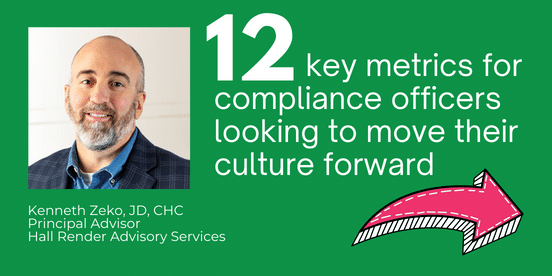
Are you spending your time on the right things?
You know the seven elements for compliance program effectiveness. They are a north star for healthcare compliance officers, and they’re at the heart of the adage “you can’t manage what you can’t measure.”
Healthcare compliance officers often rely on the seven elements as key performance indicators to measure whether their organization’s compliance goals are achieved. Yet another set of measurements – culturally impactful metrics – are equally important. These metrics guide compliance officers in leading through influence and serving as strategic business partners to the larger organization.
Both measurements are critical to ensuring that healthcare compliance officers are best positioned to help their organizations reduce risk and manage regulatory change.
Element-based KPIs
Broadly, key performance indicators (KPIs) help leaders track organization impact, financial performance, and overall business health. Within the compliance function, element-based KPIs are an effective gauge of whether compliance activities are achieving results.
For example, one common organization-wide goal is requiring 100% of new employees to complete a Code of Conduct acknowledgment. Another is an oversight goal requiring 100% of board compliance committee meetings to achieve a quorum. You might look at number of compliance audits completed or billing error rates.
All of these are meaningful measurements for compliance officers to use in helping their organizations reduce risk and manage regulatory change.
Culturally impactful metrics
What element-based KPIs don’t capture is the need for compliance officers to build relationships. A good compliance program requires collaborating with departments organization-wide. But collaboration isn’t possible if compliance officers aren’t at the right table.
Culturally impactful metrics emphasize getting compliance officers in the right rooms – ahead of regulatory change or organizational growth. These metrics underscore the importance of compliance professionals genuinely knowing the business of the organization and how it generates revenue.
Cultivating this knowledge involves developing relationships with business leaders and key operational stakeholders. With this knowledge base and established relationships, compliance professionals are prepared to lead through influence.
Examples of culturally impactful metrics include the number of:
- Compliance roadshow sessions completed
- Meetings between the compliance officer and board members, and between the compliance officer and CEO
- Surveys conducted to assess employees’ knowledge of compliance issues
- Walkthroughs conducted by the compliance officer or compliance staff
- Individual calls or questions sent to members of the compliance department
- Operational meetings/huddles attended by the compliance officer or compliance staff
- Operational compliance plan documents in existence
- Speaking engagements the compliance team participates in or articles they write
- Operational department training hosted for specific compliance issues, such as a Stark Law/Anti-Kickback Statute session for medical directors
- Compliance Week activities conducted
- Clinical roundings attended by compliance officer
- Surveys conducted to assess the organization’s culture
Winning hearts and minds
Being prepared for a regulatory or strategic change starts with compliance officers being visible across the organization. This ensures that compliance officers realize where the impact needs to be and can effectively partner with the affected operational areas to make reasonable changes and mitigate risk.
It might seem daunting to start measuring these activities throughout your year. One simple place to start is to look at where you’re spending your time now. How many hours do you spend with people outside of the compliance department? What could you simplify in your processes to give you more time to work on relationships?
With solid relationships already established, you can use your skills to sell ideas and concepts that help drive better health and business outcomes for the organization.
Download 12 Culturally Impactful Metrics (PDF)

How effective regulatory change management practices help healthcare organizations mitigate risk

Download “Empowering Compliance Officers to Drive Better Health and Business Outcomes” from YouCompli. The report includes the findings of our inaugural survey on how healthcare Compliance functions support the overall well-being of their organizations.
Throughout the paper, industry leaders deliver fresh insights on how strong regulatory change management drives risk mitigation in a healthcare organization. They discuss the value of establishing processes for regulatory change management. And they share four must-have skills for influence in a healthcare compliance role.
Contributing experts include:
- Shawn DeGroot, President, Compliance Vitals
- Charles Mazer, Director of Corporate Compliance NewYork-Presbyterian
- Ken Zeko, Principal Advisor, Hall Render Advisory Services
Never Miss an Article from Ken Zeko!
Subscribe to our newsletter today if you haven’t already!
